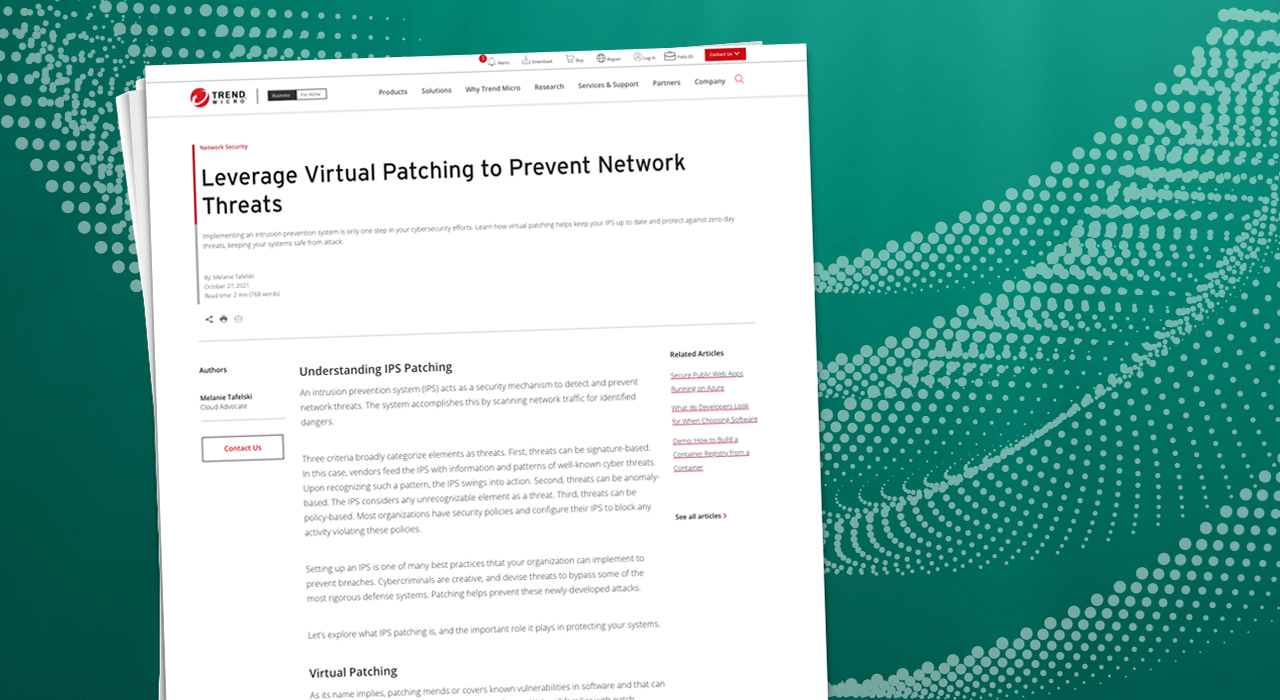Leverage Virtual Patching to Prevent Network Threats


Understanding IPS Patching
An intrusion prevention system (IPS) acts as a security mechanism to detect and prevent network threats. The system accomplishes this by scanning network traffic for identified dangers.
Three criteria broadly categorize elements as threats. First, threats can be signature-based. In this case, vendors feed the IPS with information and patterns of well-known cyber threats. Upon recognizing such a pattern, the IPS swings into action. Second, threats can be anomaly-based. The IPS considers any unrecognizable element as a threat. Third, threats can be policy-based. Most organizations have security policies and configure their IPS to block any activity violating these policies.
Setting up an IPS is one of many best practices thtat your organization can implement to prevent breaches. Cybercriminals are creative, and devise threats to bypass some of the most rigorous defense systems. Patching helps prevent these newly-developed attacks.
Let’s explore what IPS patching is, and the important role it plays in protecting your systems.
Virtual Patching
As its name implies, patching mends or covers known vulnerabilities in software and that can be both in operating system (OS) or third-party software. We’re all familiar with patch requests by software providers—these are software updates that appear on-screen periodically, warning us that the software vendor has detected and released a patch for a newly-created threat. After the user consents to the fix, the system updates to prevent bad actors from exploiting the vulnerability.
When an organization takes too long to patch vulnerabilities, bad actors can exploit them. However, IPS patching is sometimes challenging to implement because it can take a long time and be disruptive to the business flow, discouraging organizations from taking prompt action. This adversion to manually patch has led to organizations investing in virtual patching capabilites, which add layers of security to a company’s IT infrastructure, sustain the business flow, and work comfortably in physical and cloud environments.
Virtual patching is a multilayered security system used to prevent cybercriminals from exploiting both known and unknown vulnerabilities. It can detect if programs are running according to their design and inspect each program’s resources. The virtual patch intercepts threats in transit and bars them from ever getting to the web application, server, or associated endpoint. The virtual patch functions even when the application’s actual source code is unmodified. If the source code is modified, virtual patching has proven to be a quick, flexible, and cost-effective method to fix source code or server OS vulnerabilities.
An IPS can also leverage machine learning and artificial intelligence to memorize memorize regular network activity and detect abnormal behavior by implication. Machine learning can help sort the false positives from the true threats in real time, allowing you to remediate quicker and limit the scope of an attack.
Virtual patching operates on a network level and not on the device itself, allowing it to modify the network path to thwart an exploit’s progress. Due to its multilayered form, an excellent virtual patch can deeply inspect network traffic for malicious packets and prevents traffic from moving anywhere close to the vulnerability. The IPS can shield its package from the threat by modifying its network path or preventing access from specified IP addresses. An organization can patch its network by maintaining a list of devices not authorized to access its network.
Without virtual patching, organizations also leave themselves vulnerable to zero-day threats: vulnerabilities that are disclosed but not yet patched. Zero-day attacks pose a severe threat to user data because it takes time for software vendor organizations to develop and test patches than for criminals to design exploits. Even when the vendor has created the patch, most users don’t adopt it promptly. Virtual IPS patching helps organizations respond to zero-day threats quickly.
Lastly, virtual patching can help protect projects that are running on unsupported software. It can be difficult to keep up with which software vendors are still around or if they’re still running updates on their software. If unsupported software is exploited, applying a virtual patch can protect your projects and systems. No official patch needed.
Summary
IPS virtual patching serves as the first line of defense that protects networks from identified threats. It prevents malware from exploiting vulnerabilities while also enabling organizations to maintain their patching cycles.
Trend Micro Cloud One™ – Network Security provides IPS technology at the network layer while Trend Micro Cloud One™ – Workload Security protects endpoints from attacks. Both services can be accessed via Trend Micro Cloud One™, a platform comprised of seven security services.
Try it yourself with a free, 30-day trial.
Read More HERE



